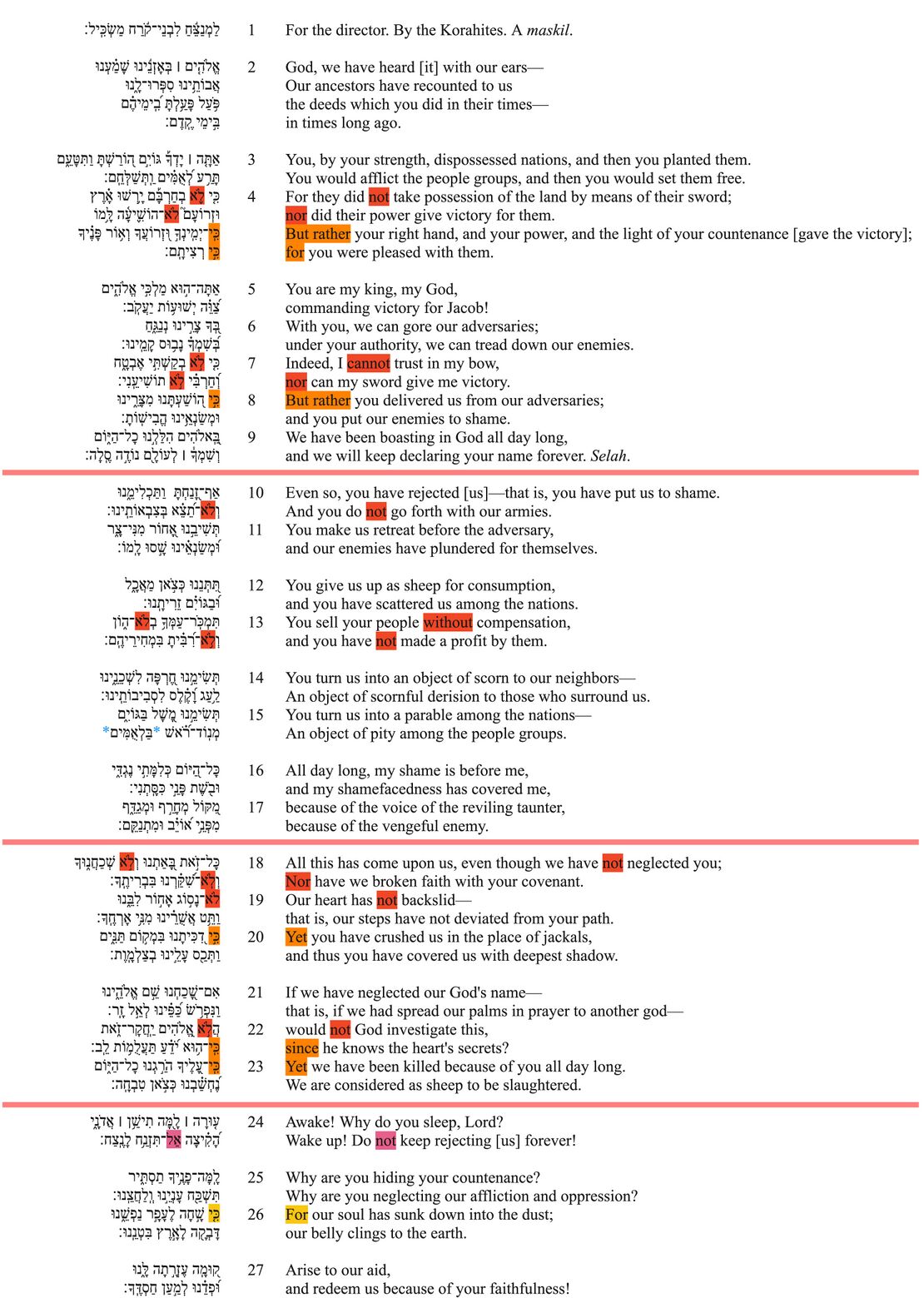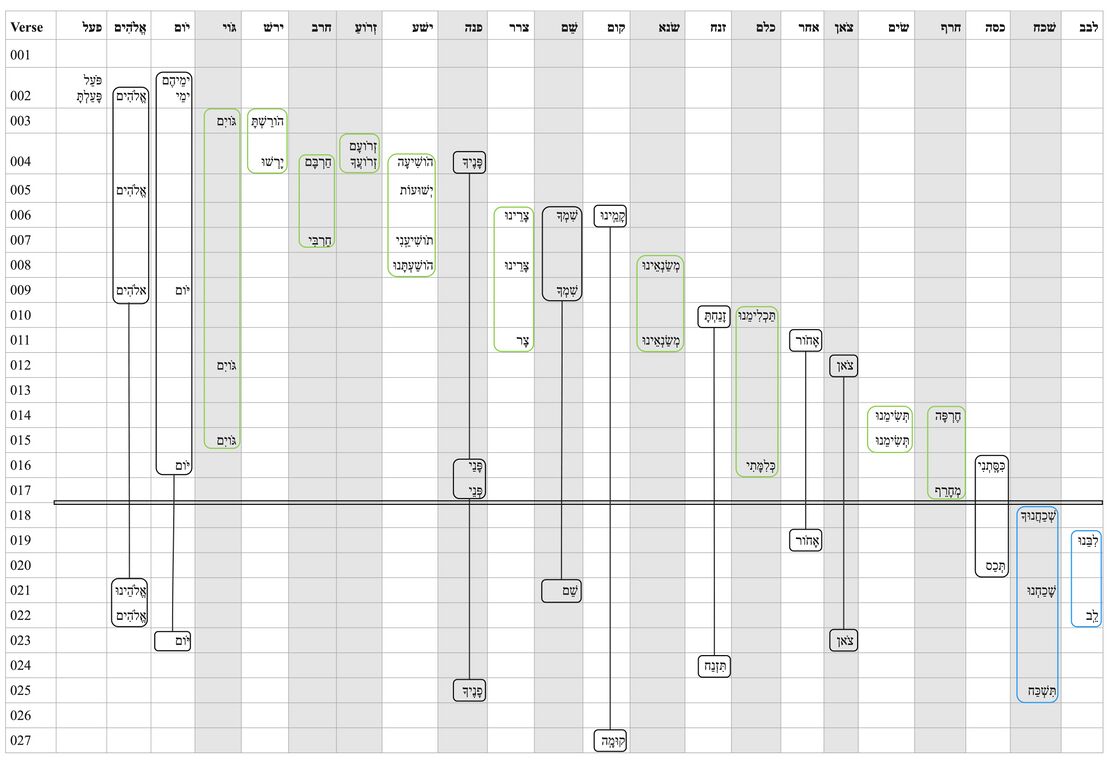Psalm 44 Poetic Features
Poetic Features
In poetic features, we identify and describe the “Top 3 Poetic Features” for each Psalm. Poetic features might include intricate patterns (e.g., chiasms), long range correspondences across the psalm, evocative uses of imagery, sound-plays, allusions to other parts of the Bible, and various other features or combinations of features. For each poetic feature, we describe both the formal aspects of the feature and the poetic effect of the feature. We assume that there is no one-to-one correspondence between a feature’s formal aspects and its effect, and that similar forms might have very different effects depending on their contexts. The effect of a poetic feature is best determined (subjectively) by a thoughtful examination of the feature against the background of the psalm’s overall message and purpose.
Double Irony
If an emendation or revocalization is preferred, that emendation or revocalization will be marked in the Hebrew text of all the visuals.
| Emendations/Revocalizations legend | |
|---|---|
| *Emended text* | Emended text, text in which the consonants differ from the consonants of the Masoretic text, is indicated by blue asterisks on either side of the emendation. |
| *Revocalized text* | Revocalized text, text in which only the vowels differ from the vowels of the Masoretic text, is indicated by purple asterisks on either side of the revocalization. |
Feature
Ps 44:2–9 begins the psalm on a positive note, which is deceptive, and sets the stage for the lament to come (Craigie 2004, 333). Aside from the positive overall tone of this initial section, the language and imagery used throughout carry connotations of covenant blessing (cf. Lev 26; Deut 28). Furthermore, by calling attention to Israel's forefathers in vv. 2–4, the psalmist taps into the concept of covenant promise.
This sense of covenant blessing, and its associations with covenant fidelity, set the reader up for an ironic twist beginning in v. 10. The descriptions of defeat and humiliation in vv. 10–17 echo the descriptions of covenant curse presented in Lev 26 and Deut 28. As such, the reader is confronted with the possibility that, contrary to initial expectations, God's people have indeed been unfaithful to their covenant obligations.
However, this presentation of suffering—and its associations with covenant curse—set the stage for a second ironic twist. Beginning in v. 18, the psalmist makes explicit that the nation has not, in fact, been guilty of violating God's covenant. Rather, Israel has been faithful to the covenant, thus leaving unexplained the reason for Israel's experience of apparent curse.
For further discussion of the background of covenant blessing and curse in Ps 44, see Story Behind.
Effect
In addition to creating a sense of surprise, this use of irony amplifies the sense of confusion and despair expressed in the psalm's laments, and highlights the urgency and desperation in its closing petition (vv. 24–27).
No! No? No!
If an emendation or revocalization is preferred, that emendation or revocalization will be marked in the Hebrew text of all the visuals.
| Emendations/Revocalizations legend | |
|---|---|
| *Emended text* | Emended text, text in which the consonants differ from the consonants of the Masoretic text, is indicated by blue asterisks on either side of the emendation. |
| *Revocalized text* | Revocalized text, text in which only the vowels differ from the vowels of the Masoretic text, is indicated by purple asterisks on either side of the revocalization. |
Feature
Ps 44 features a high number of instances of the negative particle לֹא. Notably, in the first (vv. 2–9) and third (vv. 18–23) sections of the psalm, the clauses featuring לֹא are followed up with adversative and/or explanatory כִּי-clauses. In the final section, the negative particle אַל of v. 24 is followed by another כִּי-clause of v. 26. However, these כִּי-clauses are entirely absent in the second section of the psalm (vv. 10–17).
Effect
In the first section of Ps 44 (vv. 2–9), the כִּי-clauses provide a positive balance to the preceding negative statements (in the case of the adversatives), or, in the case of v. 4d, an explanatory statement. Victory by means of human might is negated, while victory by means of God's might is positively affirmed. This is then explained on the grounds of God's favor (רצה, v. 4d).
In the psalm's third section (vv. 18–23), the כִּי-clauses provide a stark contrast to the psalmist's denials of wrongdoing (in the case of the adversatives), or, in the case of v. 22b, the explanatory grounds of the psalmist's defense. In a reversal of the first section, the positive denials of wrongdoing are balanced out by negative experiences of defeat. The psalmist's protestation of innocence is then grounded by an appeal to God's omniscience (v. 22b).
The final section of the psalm (vv. 24–27) is distinct in that it features the negative particle אַל instead of לֹא (v. 26). As אַל negates the volitional yiqtol תִּזְנַח, the distinct negative particle is in keeping with the volitional theme of this section. The explanatory כִּי of v. 26 grounds the request with an expressive appeal to God's compassion (see Speech Act Analysis).
This leaves a notable absence of explanatory or adversative כִּי-clauses in the second section of the psalm (vv. 10–17). There is no positive balance to the negative experiences, nor is there an explanation provided for their underlying cause. This phenomenon could reflect the psalmist's inability to reconcile his present circumstances with God's broader plan or character.
Patterns of Reversal
If an emendation or revocalization is preferred, that emendation or revocalization will be marked in the Hebrew text of all the visuals.
| Emendations/Revocalizations legend | |
|---|---|
| *Emended text* | Emended text, text in which the consonants differ from the consonants of the Masoretic text, is indicated by blue asterisks on either side of the emendation. |
| *Revocalized text* | Revocalized text, text in which only the vowels differ from the vowels of the Masoretic text, is indicated by purple asterisks on either side of the revocalization. |
Feature
Scholars have recognized many established poetic devices and techniques in Hebrew poetry that were commonly used to add layers of meaning to a text, such as parallelism (Watson 1986, §6) and keywording (Ibid, §11.04). However, scholars have also recognized that "inversion of an accepted or established poetic device is itself a powerful way of producing further poetic devices..." (Ibid, 357).
Psalm 44 features a number of these intentional inversions of the established devices of parallelism and keywording:
With respect to parallelism, one common form of the device is gender-matched parallelism, in which masculine and feminine nouns occur in parallel lines, with the noun genders remaining consistent within each line (Watson 1986, 123). At times, however, the poet will deliberately invert this pattern, and the parallel lines will feature corresponding nouns with opposite gender (Ibid, 124). This appears to be the case in Ps 44:14, where the feminine חֶרְפָּה is found with the masculine שְׁכֵנֵינוּ in the first line, while the masculine לַעַג וָקֶלֶס is found with the feminine סְבִיבוֹתֵינוּ in the second.
A similar reversal of expected parallelism occurs in v. 26. The words אֶרֶץ and עָפָר commonly occur together, in that specific order (Isa 26:5; 29:4; 34:7; 49:23; Ezek 24:7; Pss 7:6; 22:30; Prov 8:26; Job 14:8; 39:14). However, this order is reversed here in v. 26 (see also Isa 34:9; 47:1; Mic 7:17), and is likely an intentional inversion of the standard sequence (Watson 1986, 357).
With respect to keywords, a number of key terms are repeated throughout Ps 44, yet with a reversed referent or connotation. The term אֶרֶץ initially occurs in v. 4 as a reference to covenant blessing, yet is repeated in v. 26 as a depiction of impending death (see Semantics/Story behind the Psalm). The word פָּנֶה appears in v. 4 as an image of God's favor, a favor that is witheld in v. 25. Furthermore, the term occurs in v. 16 as a description of the psalmist's shame, and in v. 17 in relation to the mockery of enemies. The verb בושׁ refers to the shaming of enemies in v. 8, yet the nominal form refers to the psalmist's shame in v. 16.
An example of a positive reversal occurs with the verb קום, which appears as a substantival participle in v. 6, with reference to Israel's enemies; it then reappears as an imperatival request for God's assistance in v. 27.
Effect
The intentional inversion of poetic devices in Ps 44 reflects its overall message. Throughout this psalm, there is a sense of ironic reversal of expecations (see Poetic Feature 1).
The reversal of the typical pattern of gender-matched parallelism reflects the sense of reversal highlighted in the psalmist's experience. The inversion of gender-matching can be used to emphasize an unusual event, or to depict an inversion of state (Watson 1986, 127). Both functions would be suitable to the present context, and perhaps the best description of this effect is that it highlights the unusual reversal of Israel's state, from God's chosen and favored people to an object of scorn and derision.
Meanwhile, the reversal of the expected order of the paired terms אֶרֶץ and עָפָר appears to highlight a portrayal of abnormal events (Watson 1986, 357). Once again, the poetic deviation from expected patterns mirrors the inversion of covenant expectations present throughout this psalm.
This sense of reversed expectations is further reflected in the use of keywords with differing referents and connotations. Concepts typically associated with covenant blessing—the land, God's countenance, the shaming of enemies—are turned on their head to reflect Israel's experience of (what appears to be) covenant curse.
This reversal of keywords is itself turned on its head in the final verse of the psalm. A term for Israel's enemies ("those who rise against us" >> "enemies," v. 6) is repeated in its imperatival form, but this time as a plea for God's deliverance from those enemies ("Arise!" v. 27). Thus, a device that has been used throughout to highlight unexpected suffering (viz., reversals in expected usage) becomes, in the end, a plea to "reverse the reversals."
Repeated Roots
The repeated roots table is intended to identify the roots which are repeated in the psalm.
| Repeated Roots legend | |
|---|---|
| Divine name | The divine name is indicated by bold purple text. |
| Roots bounding a section | Roots bounding a section, appearing in the first and last verse of a section, are indicated by bold red text. |
| Roots occurring primarily in the first section are indicated in a yellow box. | |
| Roots occurring primarily in the third section are indicated in a blue box. | |
| Roots connected across sections are indicated by a vertical gray line connecting the roots. | |
| Section boundaries are indicated by a horizontal black line across the chart. | |









